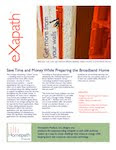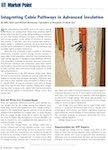The experiment we’re running with the help of the kids delivered some interesting information...and an opportunity to learn more with further study.
For background on this project see the earlier posts, Part 1 and Part 2. The investigation answers an important customer question about how eXapath affects the energy conserving qualities of insulated walls.
Specifically - ”If that thing (eXapath) is in my wall displacing some insulation, what affect does it have on energy conservation?”
As described in the earlier posts, our test chamber sits outdoors and was designed to create a large temperature gradient between the warmth contained and the cooler outside air. Using a fully insulated cube (Demilec SEALECTION™ Agribalance sprayfoam insulation provided by USInsulation) with an incandescent light bulb as a heat source, we installed the eXapath™ in-wall cable pathway system within one wall and minimized air infiltration with commonly available firestopping caulk and putty. Doing so emulates a typical home installation (see photo), allowing us to determine the affect the eXapath system has on a fully insulated exterior wall.
Once the chamber was built and checked to ensure that everything worked properly, we set it outside, allowed it to stabilize, and began to examine how the system reacted with direct exposure to the cold New England weather. Given that insulation serves only to slow down the process of heat transfer we knew that all surfaces would allow some level of heat energy to escape. We predicted that the various materials making up the walls would generate unique surface temperature profiles and the experiment sets out to demonstrate that. To determine the differences we devised a method for logging the surface temperature for three distinct locations on the walls for comparison to the outside air temperature:
- Intersection of eXapath, insulation and outer sheathing
- Intersection of insulation and sheathing
- Intersection of 2 x 6” stud and sheathing
For temperature readings we scanned (6:00 AM, 2:00 PM, 10:00 PM) the target areas daily on the outside surface of the chamber using a Ryobi Tek4 Professional Infrared (IR) Thermometer. The data was tabulated in a spreadsheet and compared to the internal and external air temperature as shown in the chart below.
Through the first four weeks of testing (tests ongoing) the internal temperature fluctuated between 75.3 and 102.5 ℉. The blue line on the chart shows the internal temperature.
During the same period the outside air temperature ranged from a low of 6.0 ℉ to a high of 53.9 ℉. The 100 Watt incandescent light bulb allowed us to drive a consistent level of energy into the test chamber and served to convert that electricity to heat. Consistent heat generation allowed the chamber itself to react to the external temperature...isolating insulation performance to the outside air temperature only. The large difference between the internal and external temperatures provided the strong temperature gradient necessary to force heat transfer to occur between the warm interior and the cool exterior.
The Bottom Line
As anticipated, all surface temperatures remained near to but slightly higher than the outside air temperature. It is hard to discern because the readings were all very close, but the lower line on the chart displays:
- Outside air temperature
- Surface temperature where eXapath, insulation, and sheathing intersect
- Surface temperature where insulation and sheathing intersect
- Surface temperature where 2 x 6” stud and sheathing intersect
A Closer Look at the Data
To assess the relative performance of the various building material combinations we sorted the data table by outside temperature in descending order. Doing so helped to reveal the performance trends more clearly. After that, we compared the variance between the external temperature and the various building material combinations...this step amplified the reported results revealing a bit more about how each material fared relative to the others under test. In essence, the outside temperature records become a reference line (zero) and the temperature difference for all other materials is plotted against the external temperature to highlight performance differences.
The main finding with the second chart is that temperature variance, compared to external air temperature, falls largely above the blue reference line...slightly higher temperature than the outside air. This is what we expected to see given the large temperature gradient between inside and outside the chamber. In cases where the surface temperatures fell below the blue reference line there is a strong correlation to rising outside temperatures....in these instances we believe the temperature changes of the construction materials lagged behind the more rapidly rising outside air temperature.
The interesting point, and the primary purpose for running this test, is that the eXapath system shows no real performance degradation despite displacing some of the insulation within the wall.
Questions Remain
It should be noted that IR thermometers offer an accuracy of ± 1.5% compared to the actual reading. In addition, the operating range for the thermometer itself ranges from 30 to 122℉. While making measurements, care was taken to keep the temperature of the IR thermometer within the operating range recommended by the manufacturer to maximize accuracy.
The Experiment Continues
To confirm the trends revealed in the experiment and support the findings of the IR thermometer we are extending the experiment to verify our findings.
While having an energy audit performed at our site we asked Chris Rhodes of Right Angle Home Inspections, a Building Analyst certified by The Building Performance Institute (BPI) and certified Level 1 Thermographer, to use her FLIR B-360 Infrared Thermography Camera to evaluate the test chamber. Our hope was to create visual identification of thermal bridging occurring through the test wall of the chamber in order to show differences between building material combinations,
The photo to the right is an infrared image of the test chamber that reveals "hot spots" or areas where heat energy is leaking out of the chamber. For clarity we've labeled the positions where the eXapath system is installed, where only insulation exists, and where a 2 x 6" stud intersects with the outer plywood sheathing. This image confirms our findings.
The three small purple patches indicate the position of digital temperature sensors we've added for phase 2 of the experiment. In phase 2 we hope to generate more detailed information to gain a more precise understanding of the differences between each building material combination.
Please check back with us for more updates soon.













.jpg)


No comments:
Post a Comment